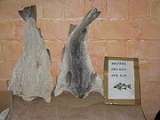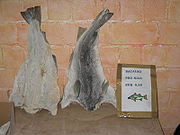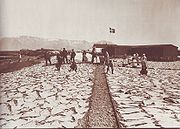
Dried and salted cod
Encyclopedia

Norwegian language
Norwegian is a North Germanic language spoken primarily in Norway, where it is the official language. Together with Swedish and Danish, Norwegian forms a continuum of more or less mutually intelligible local and regional variants .These Scandinavian languages together with the Faroese language...
, see also other names), is cod
Cod
Cod is the common name for genus Gadus, belonging to the family Gadidae, and is also used in the common name for various other fishes. Cod is a popular food with a mild flavor, low fat content and a dense, flaky white flesh. Cod livers are processed to make cod liver oil, an important source of...
which has been preserved by drying
Drying (food)
Drying is a method of food preservation that works by removing water from the food, which inhibits the growth of microorganisms and hinders quality decay. Drying food using sun and wind to prevent spoilage has been practised since ancient times, and was the earliest form of food curing...
after salting
Salting (food)
Salting is the preservation of food with dry edible salt. It is related to pickling . It is one of the oldest methods of preserving food, and two historically significant salt-cured foods are dried and salted cod and salt-cured meat.Salting is used because most bacteria, fungi and other potentially...
. Cod which has been dried without the addition of salt is called stockfish
Stockfish
Stockfish is unsalted fish, especially cod, dried by cold air and wind on wooden racks on the foreshore, called "hjell". The drying of food is the world's oldest known preservation method, and dried fish has a storage life of several years...
.
With the sharp decline in the world stocks of cod due to overfishing
Overfishing
Overfishing occurs when fishing activities reduce fish stocks below an acceptable level. This can occur in any body of water from a pond to the oceans....
, other white fish
Whitefish (fisheries term)
Whitefish or white fish is a fisheries term referring to several species of demersal fish with fins, particularly cod , whiting , and haddock , but also hake , pollock , or others...
are often used instead. Sometimes these other species are labeled as such, and sometimes still misleadingly called "salt cod", so the term has become to some extent a generic name.
Dried and salted cod has been produced in Canada
Canada
Canada is a North American country consisting of ten provinces and three territories. Located in the northern part of the continent, it extends from the Atlantic Ocean in the east to the Pacific Ocean in the west, and northward into the Arctic Ocean...
, Iceland
Iceland
Iceland , described as the Republic of Iceland, is a Nordic and European island country in the North Atlantic Ocean, on the Mid-Atlantic Ridge. Iceland also refers to the main island of the country, which contains almost all the population and almost all the land area. The country has a population...
, Faroe Islands
Faroe Islands
The Faroe Islands are an island group situated between the Norwegian Sea and the North Atlantic Ocean, approximately halfway between Scotland and Iceland. The Faroe Islands are a self-governing territory within the Kingdom of Denmark, along with Denmark proper and Greenland...
, Norway
Norway
Norway , officially the Kingdom of Norway, is a Nordic unitary constitutional monarchy whose territory comprises the western portion of the Scandinavian Peninsula, Jan Mayen, and the Arctic archipelago of Svalbard and Bouvet Island. Norway has a total area of and a population of about 4.9 million...
and Portugal
Portugal
Portugal , officially the Portuguese Republic is a country situated in southwestern Europe on the Iberian Peninsula. Portugal is the westernmost country of Europe, and is bordered by the Atlantic Ocean to the West and South and by Spain to the North and East. The Atlantic archipelagos of the...
for over 500 years. It forms a traditional ingredient of the cuisine of many countries around the Atlantic. Traditionally it was dried outdoors by the wind and sun, but today it is usually dried indoors with the aid of electric heaters.
History

Cod fishing in Newfoundland
Cod fishing in Newfoundland was carried out at a subsistence level for centuries, but large scale fishing began shortly after the European discovery of the North American continent in 1492, with the waters being found to be preternaturally plentiful, and ended after intense overfishing with the...
of the Grand Banks
Grand Banks
The Grand Banks of Newfoundland are a group of underwater plateaus southeast of Newfoundland on the North American continental shelf. These areas are relatively shallow, ranging from in depth. The cold Labrador Current mixes with the warm waters of the Gulf Stream here.The mixing of these waters...
off Newfoundland. It formed a vital item of international commerce between the New World
New World
The New World is one of the names used for the Western Hemisphere, specifically America and sometimes Oceania . The term originated in the late 15th century, when America had been recently discovered by European explorers, expanding the geographical horizon of the people of the European middle...
and the Old
Old World
The Old World consists of those parts of the world known to classical antiquity and the European Middle Ages. It is used in the context of, and contrast with, the "New World" ....
, and formed one leg of the so-called triangular trade. Thus it spread around the Atlantic and became a traditional ingredient not only in Northern European cuisine
European cuisine
European cuisine, or alternatively Western cuisine, is a generalised term collectively referring to the cuisines of Europe and other Western countries...
, but also in Mediterranean, West African, Caribbean
Caribbean cuisine
Caribbean cuisine is a fusion of African, Amerindian, British, Spanish, French, Dutch, Indian, and Chinese cuisine. These traditions were brought from the many homelands of this region's population...
, and Brazilian cuisines.
The drying of food
Drying (food)
Drying is a method of food preservation that works by removing water from the food, which inhibits the growth of microorganisms and hinders quality decay. Drying food using sun and wind to prevent spoilage has been practised since ancient times, and was the earliest form of food curing...
is the world's oldest known preservation method, and dried fish has a storage life of several years. Drying preserves many nutrients and is said to make the codfish tastier. The method was cheap, the work could be done by the fisherman or his family, and the resulting product was easily transported to market. Salting became economically feasible during the 17th century, when cheap salt from southern Europe became available to the maritime nations of northern Europe.
Traditionally, salt cod was dried only by the wind and the sun, hanging on wooden scaffolding or lying on clean cliffs or rocks near the seaside.
Names
Dried cod and the dishes made from it are known by many different names, as it became part of the cuisine of many European nations. For example, it is known as bacalhauBacalhau
Bacalhau is the Portuguese word for codfish and—in a culinary context—dried and salted codfish. Fresh cod is referred to as bacalhau fresco .-Use:...
(Portuguese), bacalao (Spanish), bakaiļao (Basque), bacallà (Catalan), morue (French), baccalà (Italian), ráktoguolli/goikeguolli (Sami), klippfisk/clipfish (Scandinavian), saltfiskur (Icelandic), bakalar (Croatian), and Saltfish (Caribbean).
The word compound bacal- and its variants are of unknown origin; explorer John Cabot
John Cabot
John Cabot was an Italian navigator and explorer whose 1497 discovery of parts of North America is commonly held to have been the first European encounter with the continent of North America since the Norse Vikings in the eleventh century...
reported that it was the name used by the indigenous inhabitants of Newfoundland. When explorer Jacques Cartier
Jacques Cartier
Jacques Cartier was a French explorer of Breton origin who claimed what is now Canada for France. He was the first European to describe and map the Gulf of Saint Lawrence and the shores of the Saint Lawrence River, which he named "The Country of Canadas", after the Iroquois names for the two big...
'discovered' the mouth of the St. Lawrence River in what is now Canada and claimed it for France
France
The French Republic , The French Republic , The French Republic , (commonly known as France , is a unitary semi-presidential republic in Western Europe with several overseas territories and islands located on other continents and in the Indian, Pacific, and Atlantic oceans. Metropolitan France...
, he noted the presence of a thousand Basque boats fishing for cod.
Process

Whitefish (fisheries term)
Whitefish or white fish is a fisheries term referring to several species of demersal fish with fins, particularly cod , whiting , and haddock , but also hake , pollock , or others...
, whereas it would not be with oily fish
Oily fish
Oily fish have oil in their tissues and in the belly cavity around the gut. Their fillets contain up to 30 percent oil, although this figure varies both within and between species...
.) It is then salted and dried ashore. Traditionally the fish was sun-dried on rocks or wooden frames
Fish flake
A fish flake is a platform built on poles and spread with boughs for drying cod-fish on the foreshore of fishing villages and small towns in rural Newfoundland, Canada. Spelling variations for fish flake in Newfoundland include flek, fleyke, fleake, flaik and fleack...
, but today it is mainly dried indoors by electrical heating. It is sold whole or in portions, with or without bones.
Species of fish
Traditionally salt cod was made exclusively of cod. After the collapse of the Grand BanksGrand Banks
The Grand Banks of Newfoundland are a group of underwater plateaus southeast of Newfoundland on the North American continental shelf. These areas are relatively shallow, ranging from in depth. The cold Labrador Current mixes with the warm waters of the Gulf Stream here.The mixing of these waters...
(and other) cod stocks due to overfishing
Overfishing
Overfishing occurs when fishing activities reduce fish stocks below an acceptable level. This can occur in any body of water from a pond to the oceans....
, some products sold as salt cod are in fact other whitefish, such as pollock
Pollock
Pollock is the common name used for either of the two species of marine fish in the Pollachius genus. Both P. pollachius and P. virens are commonly referred to as pollock. Other names for P...
, haddock
Haddock
The haddock , also known as the offshore hake, is a marine fish distributed on both sides of the North Atlantic. Haddock is a popular food fish and is widely fished commercially....
, blue whiting
Blue whiting
The blue whiting, Micromesistius poutassou, is one of the two species in the genus Micromesistius in the cod family, common in the North-East Atlantic ocean, from Morocco to Iceland and Spitsbergen. Blue whiting also occur in the North-West Atlantic ocean between Canada and Greenland. It has a...
, ling
Common Ling
The common ling or simply the ling, Molva molva, is a large member of the cod family. An ocean fish whose habitat is in the Atlantic region and can be found around Iceland, Faroe Islands, British Isles, the Norse coast and occasionally around Newfoundland, the ling has a long slender body that can...
and tusk.
Quality grades
In Norway, there used to be five different grades of salt cod. The best grade was called superior extra. Then came (in descending order) superior, imperial, universal and popular. These appellations are no longer extensively used, although some producers still make the superior products.The best klippfisk, the superior extra, is made only from line-caught cod. The fish is always of the skrei, the cod that once a year is caught during spawning
Spawn (biology)
Spawn refers to the eggs and sperm released or deposited, usually into water, by aquatic animals. As a verb, spawn refers to the process of releasing the eggs and sperm, also called spawning...
. The fish is bled while alive, before the head is cut off. It is then cleaned, filleted and salted. Fishers and connoisseurs alike place a high importance in the fact that the fish is line-caught, because if caught in a net, the fish may be dead before caught, which may result in bruising of the fillets. For the same reason it is believed to be important that the klippfisk be bled while still alive. Superior klippfisk is salted fresh, whereas the cheaper grades of klippfisk might be frozen first. Lower grades are salted by injecting a salt-water solution into the fish, while superior grades are salted with dry salt. The superior extra is dried twice, much like Parma ham. Between the two drying sessions, the fish rests and the flavour matures.

